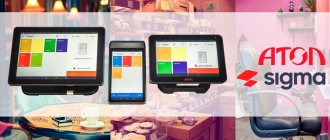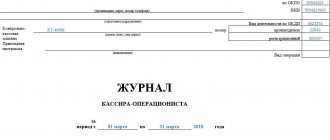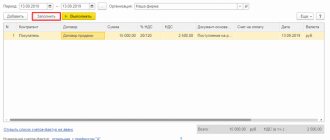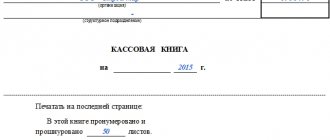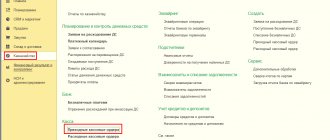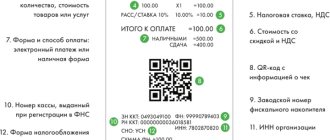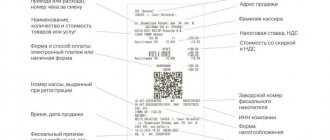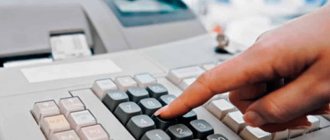What is a cash book?
Cash book (CC) is a document that records the movement of funds in the exact sequence according to primary documents. After each transaction is completed, it must be registered.
The basis for creating incoming and outgoing orders are various documents, including those generated by the online cash register. If an entrepreneur does not legally use cash register systems, then sales receipts and strict reporting forms are used.
Thus, absolutely all transactions (documented and even those that have not undergone fiscalization) are reflected in the cash book.
Goods accounting with online cash register
Accounting for goods with and without an online cash register is no different; in any case, there should be order in the warehouse. By automating warehouse accounting, you will receive several advantages at once:
- you will be able to plan purchases taking into account real demand and balances, which will not allow goods to linger on shelves or spoil;
- simplify and speed up inventory;
- reduce the likelihood of theft - when all moves are recorded, it is difficult to steal;
- eliminate accounting errors that lead to overpayment of taxes.
We offer a comprehensive solution for owners of retail and wholesale stores - “1C: UNF” or “My Warehouse” (work with online cash registers) for warehouse accounting + Finguru online accounting.
Find out how to keep your trading business running smoothly
Who should lead it and why?
Maintaining a cash book
is the responsibility
of all
legal entities.
Individual entrepreneurs are exempt from this,
but they need to maintain summary documents that show cash flows, which is an alternative to a cash book.
About limits
One of the main purposes of using a cash book is to control the business limit. At the same time, it is important to fulfill the condition: the cash balance should not exceed the limit established by law or internal documents of the company. If there is a surplus, funds are transferred to a bank account.
Cash transactions within the framework of acquiring are not reflected in the cash book, but are necessarily carried out through the online cash register.
For individual entrepreneurs, limits are not established at the legislative level. If necessary, a standard is created that regulates cash flow within the enterprise.
Who should use online cash registers
Almost all. According to this obligation, only individual entrepreneurs who:
- have no employees;
- sell goods of their own production, provide services or perform work.
The transition of such individual entrepreneurs to online cash registers must be carried out no later than July 1, 2022.
Do I need to keep a cash book if I use an online cash register?
In general terms, most companies maintain a cash book, this is an important accounting and financial control tool. It doesn’t matter whether the company uses an online cash register or not.
And the use of cash register systems acts as a special case in such economic relations.
Federal Law No. 54 does not define a rule indicating that an enterprise may not use CC, so there are no legal grounds for refusing to use it.
As a result, maintaining a cash book when using an online cash register is essentially necessary in two cases:
- A legal entity has been opened, including a small enterprise.
- The individual entrepreneur himself decided on the need for CC.
FAQ
How to conclude an agreement with OFD
There are two main ways:
- There is an official register of OFD, which you can view on the tax service website. The contract is concluded directly with one of the operators.
- The second option is to conclude an agreement through an intermediary, which is the supplier of the cash register equipment. This can be done if he has entered into a partnership agreement with the operator.
Do you need an online cash register for an online store?
This is needed if the online resource accepts payments as payment. This is regulated by Federal Law No. 54. Exceptions are described in paragraph 2 of article 2 of Federal Law-54.
What to do if there is a pick-up point for orders for an online store?
According to the law, you can use one cash register. Moreover, today some online cash register options offer their own solutions to this issue.
What about couriers who accept payment?
According to the law, the check must be knocked out at the time of payment. Therefore, every courier accepting payment must have a mobile version of the cash register.
Clarification: you cannot issue a check before payment! You can issue a check in the office if the client has already made a payment remotely and bring it along with the goods. But no later than one day after payment is made.
Is it possible to register two legal entities for one cash register?
No. Two legal entities – two cash desks.
Is it possible to open two online stores with one cash register?
Yes. The main thing is that there should be one legal entity.
Is it possible to connect an online cash register to the mobile Internet?
Yes. Moreover, it is recommended to purchase a 3G modem in advance or think through other options in case of Internet outages.
If the goods are paid for using credit, do I need to issue an online cash receipt?
Now it is recommended to configure cash registers in advance according to the appropriate parameters, especially since the check has special details that display credit transactions.
When do you need to change the fiscal drive?
- In case of breakdown
- When the owner of the cash register changes
- When the drive's memory becomes full
- When does the expiration date expire?
- When the cash register is switched to unencrypted mode.
Note: the FN manufacturer is required to extract the information free of charge in order to send it to the tax department (and also send a copy to the entrepreneur) if the cash register breaks down.
Do cashiers need to be sent to specialized courses to learn how to use an online cash register?
No need. But the work needs to be regulated. This means that a new employee who will work with the cash register must:
- Receive instructions on labor protection (this equipment operates on mains power, which means, in theory, an employee can receive an electric shock).
- Must sign the PMO agreement.
- Read and sign the rules for working with the device.
- Read the instructions for the cash register and confirm your knowledge by signing.
- Obtain login information for the work program.
All of these steps together will help minimize errors.
Does the state help in purchasing online cash registers?
Yes, assistance is provided to individual entrepreneurs, except for those who work for PSN and UTII. All other individual entrepreneurs can apply for a deduction.
Where can I get my cash register repaired?
The entrepreneur himself can do the repairs. But you need to understand that if the seal is broken, the manufacturer’s warranty is lost. Therefore, it is better to contact the supplier.
If the payment was made remotely, what should you do with the check?
The law makes it possible to deliver a check to the buyer within 24 hours after payment for the goods.
How to choose online cash register software?
If you do not understand the topic, then the best option would be to purchase equipment with pre-installed software.
What is a smart terminal
This is the name of online cash register models that were released recently and are equipped with most of the necessary functions. An analogy can be drawn with phones and smartphones, which are distinguished by greater functionality and improved technical characteristics.
Is there a deferment for self-employed people using online cash registers?
After an experiment in four regions of the country on self-employed regimes, a bill is being developed that will exempt this category from the use of online cash registers until 2022.
What to do if there is no Internet? Not at all!
Russia is large, and in some populated areas the Internet is still not installed, and the signal from the towers does not reach there. But people do business there. The law takes this into account.
If in a populated area there is no connection to the global network at all, and this is confirmed by the authorities, the entrepreneur gives the clients a paper check in the old fashioned way, and it is no longer necessary to immediately transfer the data to the tax authority. But he still has to use the cash register.
In this case, the cash register must be switched to offline mode, otherwise the drive will be blocked after some time. The data from it is transferred to the tax office along with the submission of reports.
Rules of conduct
Directive of the Central Bank No. 3210-U dated March 11, 2014 determines the procedure for maintaining a cash register, including in the case of using an online cash register:
- The beginning and end of QC maintenance coincides with the calendar beginning of the year. For new businesses founded in the middle of the year, the start of QC is determined by the date of the first transaction. If the activity ceases in the middle of the year, then the QC is completed at the same time.
- The document may be drawn up in handwritten form (using a ballpoint pen) or printed form.
- Information is entered on each line; omissions are not allowed.
- All sheets are compiled in two copies, one of which is cut off, and the second remains in the book.
- QC is carried out daily (subject to operations), and each day begins with a new sheet.
- At the end of the shifts, the CC along with the primary documents is submitted to the accounting department for verification, after which it is returned to the cashier.
- Each enterprise maintains only one QC.
Who should lead it?
A cashier at an enterprise is a financially responsible specialist in the financial sector who manages the cash register, issues and receives material assets and securities. The cashier accepts and issues accountable money, in the case of receiving cash - salaries, financial assistance, bonuses, etc., fills out income and expense papers.
The chief accountant monitors the implementation of cash transactions and the work of the cashier. There are cases where there is no position of chief accountant in an organization, then financial control is carried out by the director (general director), the head of the enterprise.
How should I fill out the cash book?
Filling out the fields of the cash book involves two main operations: entering cash inflows and cash outflows. At the end of the shift, the results are summed up.
The legislation defines the KO-4 form, according to which the cash book is drawn up. If the charter of the enterprise provides for a different form of CC, then use that one.
However, for most entrepreneurs, the statutory form is convenient and understandable, so they adhere to it.
Basic design elements
Title page Contains basic information about the organization.
The period for maintaining the document is also indicated. Cash sheets
They reflect basic information: the balance at the end of the previous shift, the income and expense of the current shift. Each transaction is entered in a specific column indicating from whom the funds were received and to whom the funds were issued. To confirm the contents, the sheets bear the signatures of the cashier and accountant.
last page
It is filled out at the end of the period. It indicates the number of sheets that are numbered and stitched, and is also signed by the manager and accountant of the enterprise.
Instructions for filling
As mentioned above, there is a prescribed form of cash book. Let's take a brief excursion into the method and form of filling out the cash book.
In order to correctly fill out the cash book, you need to know the algorithm:
- Every book starts with a cover. The cover is the face. General information is indicated on the cover, that is, the name of the enterprise or personal information of an individual entrepreneur (last name, first name and patronymic). If the book is filled out in a structural unit of the organization, then its name. Also, the title page must contain the reporting period for which the book is being opened.
- Next come the usual standard sheets of the cash book, which, in fact, reflect the transactions. Each sheet consists of two parts that are tear-off in nature. The date is indicated at the top, that is, the day for which the records are kept, as well as the sheet number. Next comes a table divided into 5 columns: document number;
- the subject (individual, enterprise, entrepreneur) from whom the amount was received or to whom the amount was issued;
- number of the corresponding account (c/s);
- income amount;
- amount of expense.
After these tables of contents, the amount at the beginning of the day (balance) is indicated, and then the table is filled in in accordance with the names of the columns.
If there are fewer transactions per day than there are lines in the table for filling in information, then the empty columns are filled in with the capital letter “Z” to avoid making additions and corrections. At the end of the table, the total amount is added, as well as the balance at the end of the day. If wages and social benefits were paid on that day, then the corresponding item in the table is filled in; if there are no such expenses, a dash is placed.
At the end, the document is signed by the cashier with a transcript of the signature and certified by the accountant with a note about receipt of the cash document in two copies.
Two filling methods
As stated above, entering information into the QC is allowed with a ballpoint pen or on a computer.
Manually
If the handwritten method is used, then the book is divided into the main and detachable parts. Copying the contents of the first part to the second is carried out using carbon paper, which is placed between them. The main part is stapled, and a copy is sent to the accounting department.
Electronic
To fill out the QC on a computer, select special software or use Excel tables in accordance with established rules. Then the printed sheets are signed and stapled.
Electronic filling of the CC does not require the use of paper media. Documents are certified with an electronic signature.
Procedure for switching to online cash registers
- Start your transition to online cash registers by obtaining a qualified electronic digital signature. To get it, you need to contact one of the accredited certification centers, submit an application, pay about 2,000 rubles and wait about three days. The validity period of the digital signature is one year.
- Select online cashier. Make sure the model is included in the approved registry.
- Enter into an agreement with the OFD from the list on the Federal Tax Service website and get access to your personal account.
- Register the fiscal registrar with the Federal Tax Service. This can be done online, through the personal account of an individual entrepreneur or legal entity on the department’s website.
- The transition to online cash registers is complete! Now that the online cash register is set up and the accounting is in place, you can legally conduct your business.
QC storage requirements
Responsibility for this lies with the head of the enterprise.
Art. 29 of Law FZ-402 dated December 6, 2011 determines the storage period for CC from 5 years from the end of the reporting year. After the specified period, the documents must be destroyed, unless a longer storage period is provided for by the company’s internal documents.
The place where the cash book is stored is the enterprise archive. It can also be given to a specialized company for storage. In this case, an agreement is drawn up between the parties and the terms of the security guarantee are indicated.
What papers do not need to be filled out?
With the introduction of online cash registers, it is no longer necessary to maintain a whole range of accounting documents. These include forms:
- KM-1: “Act on transferring the readings of summing money counters to zeros and registering control counters of cash registers”;
- KM-2: “Act on taking readings of control and summing cash meters when handing over (sending) the cash register for repairs and when returning it to the organization”;
- KM-3: “Act on the return of funds to buyers (clients) for unused cash receipts”;
- KM-4: “Journal of the cashier-operator”;
- KM-5: “Logbook of recording readings, summing cash and control counters of cash registers, operating without a cashier-operator”;
- KM-6: “Certificate-report of the cashier-operator”;
- KM-7: “Information on KKM meter readings and the organization’s revenue”;
- KM-8: “Logbook of calls to technical specialists and registration of work performed”;
- KM-9: “Act on checking cash in the cash register.”
All information previously entered into the above documents is now taken into account in the system automatically.
Who controls the maintenance of the cash book and how?
The Tax Service is responsible for checking the cash discipline of enterprises, which can impose a fine in case of violations of the law.
The task of the audit is not only to determine the correctness of the CC, but also to identify other offenses that are within the competence of the Federal Tax Service.
The following are subject to verification:
- documents related to the registration of cash transactions, including the cash book;
- reporting contained in fiscal memory;
- an order setting a limit on the cash balance;
- expense reports and other accounting documents.
The cash book is under close attention of the tax authority, as it allows you to determine how completely and timely the revenue has been recorded.
Where is the cash book located in 1C 8.3
The Cash Book report is generated by clicking the Cash Book from the Bank and cash desk - Cash desk - Cash documents section.
Using this report in 1C you can see the balance at the cash register.
Cash book sample filling.
What new paperwork do I need to fill out?
With the entry into force of Law No. 54-FZ “On the use of cash register equipment,” two new documents appeared. This is a correction check and a form with the “receipt return” sign.
The first is issued if unaccounted revenue appears. It reflects the excess amount. It is also necessary in cases where there is a power outage in the store and the cashier is conducting business by accepting cash.
The second is issued when a refund is made for a product or service. It is issued both when paying in cash and by credit card.
Reports also appeared on the opening and closing of shifts, closing of the fiscal accumulator and confirmation of the CRF on the reliability of the received data. They are not included in the list of accounting documents, so we will not consider them in detail.

